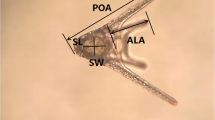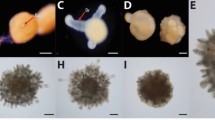Abstract
Larval survival and developmental rates of Lytechinus variegatus (Lamarck) were determined as a function of temperature and salinity in two experiments by: (1) directly transferring fertilized eggs to 35, 30, 27.5, 25, 20, 15, and 10‰S seawater at 18 and 23°C, and (2) acclimation of adult sea urchins to the conditions described above for 1 to 4 wk prior to spawning. Developmental rates and percent survival of larvae prior to metamorphosis decreased at salinities below 35‰ (Q10 values for metamorphosis=0.380 to 0.384). Temperature and salinity significantly (P<0.05) affected metabolic rates of L. variegatus plutei. These results show that L. variegatus larvae are stenohaline when compared to larvae of other echinoderm species. LC50 values (‰S), developmental rates, and survival to metamorphosis indicate that acclimation of adult sea urchins to lower salinity prior to spawing and fertilization does not enhance development or survival of embryos exposed to low salinity.
Similar content being viewed by others
Literature cited
Barrett, B. B. (1971). Cooperative Gulf of Mexico estuarine inventory and study. Louisiana. Phase II, hydrology, and Phase III, sedimentology. Louisiana Wildlife and Fisheries Commission, New Orleans
Bayne, B. L. (1985). Responses to environment stress: tolerance, resistance and adaption. In: Gray, J. S., Christiansen, M. E. (eds) Marine biology of polar regions and effects of stress on marine organisms. John Wiley & Sons Ltd, London, p. 331–349
Bayne, B. L., Moore, M. N., Widdows, J., Livingstone, D. R., Salkeld, P. (1979). Measurements of the responses of individuals to environmental stress and pollution: studies with bivalve molluscs. Phil Trans. R. Soc. 286: 563–581
Binyon, J. (1961). Salinity tolerance and permeability to water of the starfish Asterias rubens L. J. mar. biol. Ass. U.K. 41: 161–174
Binyon, J. (1966) Salinity tolerance and ionic regulation. In: Boolootion, R. A. (ed.) Physiology of Echinodermata. Interscience Publishers, New York, p. 359–377
Binyon, J. (1972). Physiology of Echinodermata. Pergamon Press Ltd, Oxford
Calabrese, A., Davis, H. C. (1970). Tolerance and requirements of embryos and larvae of bivalve mollusks. Helgoländer wiss. Meeresunters. 20: 553–564
Collias, E. E., McGray, N., Barnes, C. A. (1974). Atlas of physical and chemical properties of Puget Sound and its approaches. University of Washington Press, Seattle
Drouin, G., Himmelman, J. H., Beland, P. (1985). Impact of tidal salinity fluctuations on echinoderm and mollusc populations. Can. J. Zool. 63: 1377–1387
Finney, D. J. (1971). Probit analysis. 3rd edn. Cambridge University Press, London
Fuhrman, J., Fuhrman, A. (1959). Oxygen consumption of animals and tissues as a function of temperature. J. gen Physiol. 42: 715–722
Gezelius, G. (1963). Adaptation of the sea urchin Psammechinus miliaris to different salinities. Zool. Bidr. Upps. 35: 329–337
Grasshoff, H., Johannsen, H. (1972) A new sensitive and direct method for the automatic determination of ammonia in seawater. J. Cons. int. Explor. Mer 34: 516–521
Greenwood, P. J., Bennett, T. (1981). Some effects of temperaturesalinity combinations on the early development of the sea urchin Parechinus angulosus (Leske). Fertilization. J. exp. mar. Biol. Ecol. 51: 119–131
Guillard, R. R. L. (1975). Culture of phytoplankton for feeding marine invertebrates. In: Smith, W. L., Chanley, M. H. (eds.) Culture in marine animals. Plenum Press, New York, p. 29–30
Hendler, G. L. (1973). Northwest Atlantic amphiurid brittlestars, Amphioplus abditus (Verrill), Amphioplus macilentus (Verrill), and Amphioplus sepultus n. sp. (Ophiuroidea: Echinodermata): systematics, zoologeography, annual periodicities and larval adaptations. Ph.D. disseration. University of Connecticut, Storrs
Hendler, G. L. (1977). Development of Amphioplus abditus (Verrill) (Echinodermata, Ophiuroidea): I. Larval biology. Biol. Bull. mar. biol. Lab., Woods Hole 152: 51–63
Hewatt, W. G. (1951). Salinity studies in Louisiana coastal embayments west of the Mississippi River. Final Report of Project Nine. Texas A&M Research Foundation, College Station
Himmelman, J. H., Lavergne, Y., Axelsen, F., Cardinal, A., Bourget, E. (1983). Sea urchins in the St. Lawrence estuary Canada, their abundance size structure and suitability for commercial exploitation. Can. J. Fish. aquat. Sciences 40: 474–486
Hoar, W. S. (1969). Reproduction. In: Hoar, W. S., Randall, D. J. (eds.), Fish physiology. Academic Press, New York, p. 1–72
Johns, D. M. (1981 a). Physiological studies on Cancer irroratus larvae. II. Effects of temperature and salinity on survival, development rate and size. Mar. Ecol. Prog. Ser. 5: 75–83
Johns, D. M. (1981 b). Physiological studies on Cancer irroratus larvae. II. Effects of temperature and salinity on physiological performance. Mar. Ecol. Prog. Ser. 6: 309–315
Johns, D. M. (1982). Physiological studies on Cancer irroratus larvae. III. Effects of temperature and salinity on the partitioning of energy resources during development. Mar. Ecol. Prog. Ser. 8: 75–85
Klinger, T. S., Hsieh, H. L., Pangallo, R. A., Chen, C. P., Lawrence, J. M. (1986). The effects of temperature on feeding, digestion, and absorption of Lytechinus variegatus (Lamarck (Echinodermata: Echinoidea). Physiol. Zoöl. 59: 332–336
Kozloff, E. N. (1974). Key to the marine invertebrates of Puget Sound, the San Juan Archipelago, and adjacent regions. University of Washington Press, Seattle
Laughlin, R. (1983). The effects of temperaure and salinity on larval growth of the horseshoe crab Limulus polyphemuns. Biol. Bull. mar. biol. Lab., Woods Hole 164: 93–103
Lawrence, J. M. (1975). The effect of temperature-salinity combinations on functional well-being of adult Lytechinus variegatus (Lamarck) (Echinodermata, Echinoidea). J. exp. mar. Biol. Ecol. 18: 271–275
Loosanoff, V. L. (1945). Effect of seawater of reduced salinities upon the starfish Asterias forbesi of Long Island Sound. Trans. Conn. Acad. Arts Sci. 36: 813–833
Lucas, J. S., Costlow, J. D., Jr. (1979). Effects of various temperature cycles on the larval development of the gastropod mollusc Crepidula fornicata. Mar. Biol. 51: 111–117
Lucke, B., McCutcheon, M. (1932). The living cell as an asmotic system and its permeability to water. Physiol. Rev. 12: 68–139
MacInnes, J. R., Calabrese, A. (1979). Combined effects of salinity, temperature, and copper on embryos and early larvae of the American oyster, Crassostrea virginica. Archs envir. Contam. Toxic. 8: 553–562
Mangum, C. F., Sassaman, C. (1969). Temperature sensitivity of active and resting metabolism in a polychaetous annelid. Comp. Biochem. Physiol. 30: 111–116
Moore, H. B., Lopez, N. N. (1972). Factors controlling variation in the seasonal spawning pattern of Lytechinus variegatus. Mar. Biol. 14: 275–280
Mortensen, T. H. (1943). Monograph of Echinoidea III. 2. Camarodonta. I. Orthopsidae, Glyphooyphidae, Temnopleuridae and Toxopneustidae. C. A. Reitzel, Copenhangen
Oglesby, L. C. (1981). Volume regulation in acquatic invertebrates. J. exp. Zool. 215: 289–301
Pagett, R. M. (1978). Some physiological and ecological aspects of the Ophiuroidea. Ph.D. thesis. University of London, London
Petersen, J. A., Almeida, A. M. (1976). Effects of salinity and temperature on the development and survival of the echinoids Arbacia, Echinometra and Lytechinus. Thalassia jugosl. 12: 297–298
Prosser, C. L. (1986). Adaptational biology: molecules to organisms. John Wiley & Sons, New York
Roller, R. A., Stickle, W. B. (1985). Effects of salinity on larval tolerance and early developmental rates of four species of echinoderms. Can. J. Zool. 63: 1531–1538
Roller, R. A., Stickle, W. B. (1989). Temperature and salinity effects on the intracapsular development, metabolic rates, and survival to hatching of Thais haemastoma (Gray) (Prosobranchia: Muricidae) under laboratory conditions. J. exp. mar. Biol. Ecol. 125: 235–251
Roller, R. A., Stickle, W. B. (1993). Does salinity acclimation affect the larval tolerance, physiology, and early development of Strongylocentrotus droebachiensis (O. F. Müller, 1776) and S. pallidus (G. O. Sars, 1871) (Echinodermata: Echinoidea)? (In preparation)
Sabourin, T. D., Stickle, W. B. (1981). Effects of salinity on respiration and nitrogen excretion in two species of echinoderms. Mar. Biol. 65: 91–99
SAS Institute Inc. (1985 a). SAS for linear models — a guide to the ANOVA and GLM procedures. SAS Institute Inc., Cary, North Carolina
SAS Institute Inc. (1985 b). SAS users guide: statistics. Version 5 edn. SAS Institute Inc., Cary, North Carolina
Schmidt-Nielsen, K. (1980). Animal physiology: adaptation and environment. Cambridge University Press, London
Serafy, K. (1973). Variation in the polytypic sea urchin Lytechinus variegatus (Lamarck, 1816) in the western Atlantic (Echinodermata; Echinoidea). Bull. mar. Sci. 23: 525–534
Serafy, K. (1979). Echinoids (Echinoidea: Echinodermata). Mem. Hourglass Cruises. 5: 1–120 (Fla mar. Res. Lab., St Petersburg)
Shirley, T. C., Stickle, W. B. (1982). Responses of Leptasterias hexactis (Echinodermata: Asteroidea) to low salinity. I. Survival, activity, feeding, growth and absorption efficiency. Mar. Biol. 69: 147–154
Silverstone, H. (1957). Estimating the logistic curve. J. Am. statist. Ass. 52: 567–577
Snedecor, G. W., Cochran, W. G. (1980). Statistical methods. 7th ed. Iowa State University Press, Ames, p. 290–291
Sokal, R. R., Rohlf, F. J. (1981). Biometry. The principles and practice of statistics in biological research. 2nd ed. W. H. Freeman & Co., New York
Solórzano, L. (1969). Determination of ammonia in natural waters by the phenol hypochlorite method. Limnol. Oceanogr. 14: 799–801
Stancyk, S. E., Shaffer, P. L. (1977). The salinity tolerance of Ophiothrix angulata (Say) (Echinodermata: Ophiuroidea) in latitudinally separate populations. J. exp. mar. Biol. Ecol. 29: 35–43
Steel, R. G. D., Torrie, J. H. (1980). Principles and procedures of statistics: a biomedical approach. McGraw-Hill Inc., New York
Stickle, W. B. (1985). Effects of environmental factor gradients on scope for growth in several species of carnivorous marine invertebrates. In: Gray, J. S., Christiansen, M. E. (eds.) Marine biology of polar regions and effects of stress on marine organisms. John Wiley & Sons Ltd., London, p. 601–616
Stickle, W. B., Denoux, G. J. (1976). Effects of in situ tidal salinity fluctuations on osmotic and ionic composition of body fluid in Southeastern Alaska rocky intertidal fauna. Mar. Biol. 37: 125–135
Stickle, W. B., Diehl, W. J. (1987). Effects of salinity on echinoderm. In: Jangoux, M., Lawrence, J. M. (eds.) Echinoderm studies. II. A. A. Balkema, Rotterdam, p. 235–285
Strathmann, M. (1987). Reproduction and development of marine invertebrates of the northern Pacific coast: data and methods for the study of eggs, embryos, and larvae. University of Washington Press, Seattle
Strathmann, R. (1978). Length of pelagic period in echinoderms with feeding larvae from the Northeast Pacific. J. exp. mar. Biol. Ecol. 34: 23–27
Strickland, J. D. H., Parsons, T. R. (1972). A practical handbook of seawater analysis. 2nd edn. Bull. Fish. Res. Bd Can. 167: 1–310
Thomas, L. P. (1961). Distribution and salinity tolerance in the amphiurid brittlestar Ophiophragmus filograneus (Lyman 1875). Bull. mar. Sci. Gulf Caribb. 11: 158–160
Thomson, R. E. (1981). Oceanography of the British Columbia Coast. Department of Fisheries and Oceans. Ottawa, Ontario
Thorson, G. (1950). Reproductive and larval ecology of marine bottom invertebrates. Biol. Bull. mar. biol. Lab., Woods Hole 25: 1–45
Turner, R. L., Meyer, C. E. (1980). Salinity tolerance of the brackish-water echinoderm Ophiophragmus filograneus (Ophiuroidea). Mar. Ecol. Prog. Ser. 2: 249–256
Valen, E. (1958). Oxygen consumption in relation to temperature in some poikilotherms. Acta physiol. scand. 42: 358–362
Valentine, J. F., Heck, K. L. (1991). The role of sea urchin grazing in regulating subtropical seagrass meadows: evidence from field manipulations in the northern Gulf of Mexico. J. exp. mar. Biol. Ecol. 154: 215–230
Vernberg, W. B., Vernberg, F. J. (1972). Environmental physiology of marine animals. Springer-Verlag, New York
Watts, S. A., Scheibling, R. E., Marsh, A. G., McClintock, J. B. (1982). Effects of temperature and salinity on larval development of sibling species of Echinaster (Echinodermata: Asteroidea) and their hybrids. Biol. Bull. mar. biol. Lab., Woods Hole 163: 348–354
Widdows, J., Phelps, D. K., Galloway, W. (1981). Measurement of physiological condition of mussels transplanted along a pollution gradient in Narragansett. Bay. Mar. envirl Res. 4: 181–194
Wieser, W. (1973). Temperature relations of ectotherms: a speculative review. In: Wieser, W. (ed.) Effects of temperature on octothermic organisms. Springer-Verlag, New York, p. 1–23
Author information
Authors and Affiliations
Additional information
Communicated by N. H. Marcus, Tallahassee
Rights and permissions
About this article
Cite this article
Roller, R.A., Stickle, W.B. Effects of temperature and salinity acclimation of adults on larval survival, physiology, and early development of Lytechinus variegatus (Echinodermata: Echinoidea). Marine Biology 116, 583–591 (1993). https://doi.org/10.1007/BF00355477
Received:
Accepted:
Issue Date:
DOI: https://doi.org/10.1007/BF00355477




